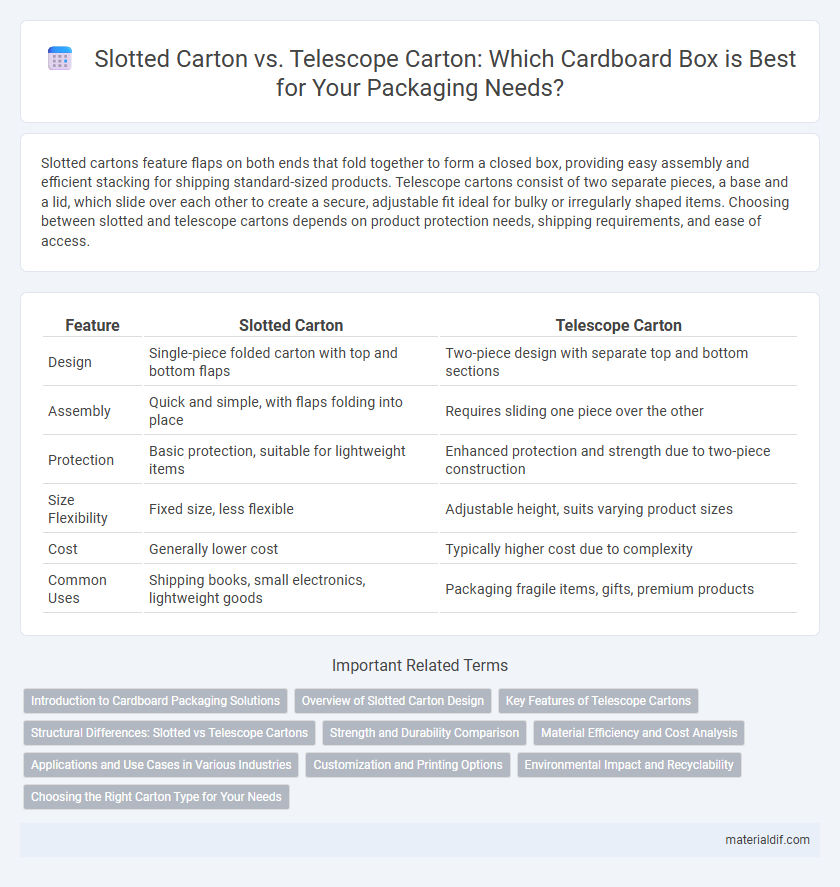Slotted cartons feature flaps on both ends that fold together to form a closed box, providing easy assembly and efficient stacking for shipping standard-sized products. Telescope cartons consist of two separate pieces, a base and a lid, which slide over each other to create a secure, adjustable fit ideal for bulky or irregularly shaped items. Choosing between slotted and telescope cartons depends on product protection needs, shipping requirements, and ease of access.
Table of Comparison
| Feature | Slotted Carton | Telescope Carton |
|---|---|---|
| Design | Single-piece folded carton with top and bottom flaps | Two-piece design with separate top and bottom sections |
| Assembly | Quick and simple, with flaps folding into place | Requires sliding one piece over the other |
| Protection | Basic protection, suitable for lightweight items | Enhanced protection and strength due to two-piece construction |
| Size Flexibility | Fixed size, less flexible | Adjustable height, suits varying product sizes |
| Cost | Generally lower cost | Typically higher cost due to complexity |
| Common Uses | Shipping books, small electronics, lightweight goods | Packaging fragile items, gifts, premium products |
Introduction to Cardboard Packaging Solutions
Slotted cartons feature flaps on both the top and bottom that interlock to close the box securely, making them ideal for efficient packing and shipping. Telescope cartons consist of two separate pieces, a base and a lid, which fit over each other to provide adjustable depth and superior protection for fragile or oddly shaped items. Both options offer versatile cardboard packaging solutions tailored to different shipment requirements and product protection needs.
Overview of Slotted Carton Design
Slotted cartons feature overlapping flaps on both the top and bottom, which fold to create a secure closure without the need for adhesive, making them ideal for easy assembly and cost-effective packaging. Their design allows for customizable sizes and shapes to accommodate various product dimensions, enhancing protection during shipping and handling. Commonly used in industries like retail and food packaging, slotted cartons offer versatile and efficient solutions for lightweight to medium-weight items.
Key Features of Telescope Cartons
Telescope cartons feature a two-piece design consisting of a separate lid and base, allowing for adjustable height to accommodate varying product sizes. The overlapping lid provides extra protection and rigidity, making it ideal for fragile or heavy items during shipping and storage. Unlike slotted cartons, telescope cartons offer enhanced versatility and cushioning, ensuring better product security.
Structural Differences: Slotted vs Telescope Cartons
Slotted cartons consist of a single-piece design with overlapping flaps on the top and bottom that can be easily folded and sealed, providing efficient assembly and cost-effectiveness. Telescope cartons feature two separate pieces--a sleeve and a cover--that fit over one another, offering enhanced protection and greater adjustability for varying product heights. The structural difference lies in slotted cartons' integrated flap system versus telescope cartons' two-piece construction, which affects durability, assembly speed, and application suitability.
Strength and Durability Comparison
Slotted cartons feature overlapping flaps that enhance stacking strength and provide reliable protection against crushing forces, making them ideal for heavier items. Telescope cartons, composed of a separate top and bottom section, offer adjustable depth and exceptional durability through double-walled construction, ensuring superior resistance to impact and moisture. Both carton types deliver robust performance, but telescope cartons typically outperform slotted cartons in sustained durability and load-bearing capacity.
Material Efficiency and Cost Analysis
Slotted cartons typically use a single piece of cardboard folded to form the box, maximizing material efficiency by minimizing waste and reducing production costs compared to telescope cartons, which require two separate pieces for the base and lid, leading to higher material consumption and assembly time. Cost analysis reveals that slotted cartons are generally more economical for high-volume orders due to streamlined manufacturing processes, while telescope cartons, despite increased material use, offer better protection and customization for premium products. Selecting between the two depends on balancing material efficiency with product protection needs and budget constraints.
Applications and Use Cases in Various Industries
Slotted cartons, with their straightforward design and easy assembly, are widely used in packaging consumer goods, electronics, and food products where quick access and lightweight protection are essential. Telescope cartons offer superior strength and adjustable height, making them ideal for industries such as automotive, furniture, and industrial equipment that require robust protection during shipping and storage. Both carton types serve critical roles by balancing cost-efficiency and durability across retail, manufacturing, and logistics sectors.
Customization and Printing Options
Slotted cartons offer straightforward customization with single or multi-color printing options ideal for branding and product information, suitable for efficient packaging designs. Telescope cartons provide enhanced customization capabilities, allowing complex printing and full-surface graphics that create premium packaging aesthetics and improved consumer appeal. Both carton types support eco-friendly inks and finishes, but telescope cartons enable more intricate visual presentations for high-end product differentiation.
Environmental Impact and Recyclability
Slotted cartons, constructed from a single piece of corrugated cardboard, offer high recyclability due to minimal material use and ease of flattening during waste processing, reducing environmental impact. Telescope cartons, made from two separate pieces, require more material and complex assembly, leading to increased resource consumption and potentially lower recycling rates. Choosing slotted cartons supports sustainable packaging initiatives by minimizing waste and promoting efficient recycling practices.
Choosing the Right Carton Type for Your Needs
Slotted cartons offer easy assembly with their scored flaps folding inward, ideal for lightweight items and quick packaging. Telescope cartons consist of a separate base and lid, providing adjustable height and better protection for fragile or irregularly shaped products. Selecting the right carton depends on product size, weight, fragility, and storage requirements, ensuring optimal protection and cost-efficiency.
Slotted carton vs Telescope carton Infographic

 materialdif.com
materialdif.com